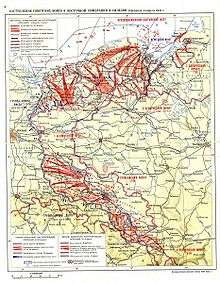Silesian Offensives


The Silesian Offensives were two 1945 offensives conducted by the Soviet Red Army against the Nazi German Wehrmacht on the Eastern Front in World War II.
The offensives
The Lower Silesian Offensive ran from 8–24 February 1945, and the Upper Silesian Offensive from 15–31 March. Designed to flank the Soviet main advance on Berlin, the two operations pushed the Wehrmacht out of Silesia.
According to Soviet information, the Germans lost in the Upper Silesian Offensive 40,000 dead soldiers and 14,000 captured.[1]
The 1st Ukrainian Front under Ivan Konev’s command—having completed the Vistula-Oder Offensive—was to advance westward toward Silesia with the primary objective of protecting the left flank of the 1st Belorussian Front, which was pushing toward Berlin. Similarly, the East Pomeranian Offensive of the 2nd Belorussian Front in the north was tasked with protecting the 1st Belorussian Front's right flank.
Delay
The need to secure the flanks delayed till April the Soviets' final push toward Berlin, which had originally been planned for February. By mid-April, the East Pomeranian Offensive—carried out by the 2nd, and elements of the 1st, Belorussian Fronts—had succeeded in its objectives, reaching the important German port city of Stettin (now Szczecin).
Motives
Joseph Stalin's decision to delay the push toward Berlin from February -April 1945 has been a subject of controversy among Soviet generals and military historians, with one side arguing that in February the Soviets had a chance of securing Berlin much faster and with much smaller losses, and the other arguing that the possibility of large German formations (remnants of the Czech fortification system) remaining on the flanks could have resulted in a successful German counterattack and further prolonged the war. Stalin's aim in delaying the advance on Berlin had likely been political, as it allowed him to occupy substantial parts of Austria in the Vienna Offensive.
See also
External links
- (Polish), Andrzej Wanderer, Piekło na Śląsku, Tygodnik Prudnicki nr 24, 2006-06-14
Further reading
- Beevor, Antony. Berlin: The Downfall 1945, Penguin Books, 2002, ISBN 0-670-88695-5
- Duffy, Christopher. Red Storm on the Reich: The Soviet March on Germany, 1945, Routledge, 1991, ISBN 0-415-22829-8
- Dubiel, P. Wyzwolenie Śląska w 1945 r. [Liberation of Silesia in 1945], Katowice 1969
- Karl Friedrich Grau, Silesian Inferno: War Crimes of the Red Army on Its March Into Silesia in 1945: a Collection of Documents, Landpost Press, 1992, ISBN 1-880881-09-8
- Rawski, T. Wyzwolenie Śląska [Liberation of Silesia], Studia i Materiały z Dziejów Śląska, t. VI, 1964
References
- Glantz, David M., The Soviet‐German War 1941–45: Myths and Realities: A Survey Essay